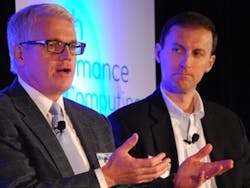Check Out Montague's Google+ profile.
The gap between business-level IT computing and its counterparts on the plant floor is narrowing in many places, but there remain yawning canyons in others. Despite the challenges, the Industrial Internet is bringing the benefits of commercial connectivity and collaboration platforms to the realm of manufacturing. These gains were described by a panel of experts at GE Intelligent Platforms' Connected World event on October 15 at the Hyatt Regency Hotel in Chicago. Their discussion, entitled "How Today's Connected World is Transforming Industry," was moderated by Chris Murphy of Information Week magazine."There are a lot of proprietary systems in the process world," explained Carlos Rojas, mobility director at Cisco. "And while Cisco runs on open standards, both sides can benefit the overall enterprise. Convergence is important and real, but it can't happen overnight. The industrial world doesn't fare well when IT says it's just going to come in and connect up everything. Engineers want to know how they're going to keep their world secure and safe, and this means identifying cyber security entry points."
Jay Neidermeyer, CIO at GE Aviation, reported that, "We build complex engines, and they're made by even more complex machines that have to be up and running, so we can make our deliveries on time. We're also learning to interrogate our enterprise resource planning (ERP) systems and analyze supplier behaviors, so we can better anticipate when new shipments will be needed based on past needs. There are some big opportunities to be gained by making these connections."
Peter Hock, senior director of continuous improvement at ConAgra Foods, explained, "We see two main opportunities coming from connectivity. For instance, the moisture content in flour and other products varies by silo, and so there's a big opportunity if we can identify those variations earlier, and adjust our controls. In the past, there's been a lot of work creating data visibility for management, but there hasn't been enough done to put the right data in the hands of operators, who can do as much as management to add value to asset points in the production chain, such as by identifying poor performance during a shift instead of after. That's what we want to explore."
Also Read: The Energy Internet, Part 2
Jody Markopoulos, CEO of GE Intelligent Platforms, added that, "There are multiple verticals involved here from water to oil and gas to food and beverage, and all kinds of different assets, devices and enterprises. Improved connectivity via the Industrial Internet, which connects brilliant machines, advanced analytics and working people, can better optimize their applications, and dramatically improve their productivity and efficiency by reducing problems like previously unplanned downtime. And, even though this can be done at many different levels, the underlying technologies and solutions are very similar."
Accomplishing this wide-ranging optimization requires users to serve three primary masters, according to Mike Milburn, operations vice president for Salesforce.com's service cloud. "You have to meet the needs of a lot of people, but then also maintain security and uptime, and serve large, medium and small users and systems all at the same time," explained Milburn.
"Industrial Internet connectivity is a big game-changer for us." ConAgra's Peter Hock on the food processor's progress in making key information more readily available to the decision-makers who need it.
"LinkedIn is layering more of the people component into machines," added Kevin Krantz, vice president of sales at LinkedIn. "We have the connectivity to make this doable today. Machines should be able to recommend to their users who can help solve a particular problem, find who has experience with its technology, and even help schedule maintenance and repairs for them."Rojas stated that useful data is the biggest driver of optimization and new capabilities. "Operations managers securing insights into key performance metrics is what everyone huddles around, but there are hurdles that IT has to get over to reach these new levels of performance," said Rojas. "For example, in a recent Chilean mining application, the IT side knew it needed a backbone, and used Ethernet via a hardened network. It's not 100% adopted yet, and there are multiple parts to address, but they've already found many opportunities they hadn't seen before."
Despite connectivity's obvious advantages, Hock added that linking equipment and applications more closely to the Internet still feels like dealing with the unknown to many potential users. "Most manufacturers are biased, and often feel like there's a heightened risk to doing it," he said.
Neidermeyer explained, "We're really at an inflection point where it's becoming crucial for our teams to have Internet connectivity to keep them on the same page. However, no one has all the right solutions, and they can't be sure they're playing the right end game."
Because of its longtime expertise in process controls, software solutions and supervisory control and data acquisition (SCADA) for analytics, Markopoulos reported that GE Intelligent Platforms can talk to people at many different operational levels and help them with their applications. "Everyone has different problems to solve, but we can connect the dots for individual asset owners, and listen to original equipment manufacturers (OEMs) and machine providers in their own terms to solve problems," she explained. "What we're learning now is that LinkedIn and other social media have a lot of meaning for the industrial world because they can help users convey their domain expertise, and provide differentiated value to their customers."
"We give data to the enterprise level, so the visualization and action layers on the IT and business sides can make better decisions," explained Milburn. "Salesforce.com brokers relationships, and we've found it's possible to move at the speed of business, but still be safe doing it. IT's job is to be a matchmaker and marriage counselor, and help users ‘fail fast' as they search for what works best for them. Failing fast means trying possible solutions with no stigma attached, and moving forward without finger-pointing."
Krantz agreed that industrial Internet connectivity is extremely beneficial, but he cautioned that the massive data sets generated by these ties must be sorted for actionable information. "Our job at LinkedIn is to help users filter their data, stay focused, and drive innovation," he said. "Three years in our business is a lifetime, and so solving operational challenges by failing fast is a necessity. As a result, we have performance areas to focus on, and then drill down into them. In fact, these things happen so quickly that there's always a danger of technology driving the business focus, instead of the other way around, and so this potential problem has to be managed carefully. In the past, just having access to this kind of data was a homerun, but now everyone has access, and so the differentiator is collating data to reach what's needed to diagnose specific problems and help organizations continue to grow."
Rojas agreed: "Customers are often very enamored of new technology, and so we ask them to clearly define their business case first to decide which ones will be the most beneficial to them. We have many examples of the Internet of Things (IoT), but it's more than just generating key metrics. IoT can also produce overall business guidelines for better asset utilization, supply chain optimization, technical innovations and improved customer experiences. It starts with IoT, but its goal is serving the plant and the business."
Also Listen to: The Internet of Things
While all the advantages of industrial Internet connectivity can be intoxicating, these advances are only possible if they can be done securely. "We're very careful where our information goes," said Neidermeyer. "We go to great lengths to wall off sensitive information from the outside, but sometimes we're so secure that we wall it off from ourselves and where it can be used best, so it's important to maintain the right balance."
Hock added that ConAgra's production data is hardwired into its many programmable logic controllers (PLCs), but it still needs to get more of the right information to its operators. "Many existing data delivery solutions are still pretty clunky," said Hock. "Now, we're moving to using more smart phones, tablet PCs and other devices, which can display the online playbooks that our operators can use to perform their jobs better. However, there are so many devices out there that it's like being a kid in a candy shop, and so we have to research and narrow our focus down to the best solution for us. It's also important to adopt these new connectivity solutions in small projects at first, get critical people to use them, and then take baby steps to apply them in larger areas."
Markopoulos added, "Successful connectivity depends on how each user defines and applies it to their own process and business. Some want to optimize the machines in their plant, while others want to set up their own internal, enterprise-level cloud. It just depends on what's most relevant to you, and then deciding what precious resources, brain power and task will benefit the most from having manuals or other useful data at their fingertips via these new tools."
"In ConAgra's factories, there are core sets of data for productivity, and users apply different levels of granularity, so they can understand and react to what's going on in their applications and areas," explained Hock. "For example, the number of units produced per hour is one of our important measures, but we can use our new connectivity devices to eliminate some of the background noise around it. Previously, we had to rely more on hunches, so that's why Industrial Internet connectivity is a big game changer for us."
GE Aviation's Neidermeyer added, "Unfortunately, we're still having to fight some old battles again. If a person has been able to predict equipment outages for many years just by hearing it rattle, then it can be very hard convince them that a computer can do the same thing. So, before making any new gains, we need simple ways to demonstrate these successes, and show people that they're real and can work better than traditional machine whisperers."
Hock reported, "We're already using Industrial Internet connectivity to gather production data and run equipment in accordance with predictive principles. Connectivity has been very helpful in our efforts."







